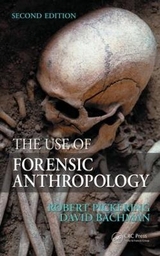
The Use of Forensic Anthropology
Crc Press Inc (Verlag)
978-0-8493-8111-9 (ISBN)
- Titel erscheint in neuer Auflage
- Artikel merken
Forensic analysis has become and will continue to be a complicated and highly specialized field of study. Forensic investigations require teams of specialists from many different scientific fields in addition to legal and law enforcement personnel. Of the many specialties that are used in death investigations, forensic anthropology is most often associated with the analysis of skeletalized human remains.
This volume provides guidelines for determining when to include and how to choose a forensic anthropologist in your investigations. The Use of Forensic Anthropology is written with the assumption that the reader is not a trained anthropologist, and goes by the premise that most law enforcement professionals simply want to know how a forensic anthropologist is going to help them do their job. Many examples and anecdotes are offered by the authors, who strive to keep the text at a clear, readable level that is informative yet enjoyable to read. Jargon is purposefully kept to a minimum, but when it is used it is defined in context so that a common use and understanding of the terms can be achieved.
Coroners, medical examiners, pathologists, crime scene investigators, local and state police, and anyone working in a crime laboratory can benefit from this easy to understand guide on when to use and how to choose a forensic anthropologist.
Introduction
Some Bones Have Been Found
Setting the Scene
What the Forensic Anthropologist Can and Cannot Do
Finding a Forensic Anthropologist
Sidebar on Physical Anthropology/Forensic Anthropology
What the Forensic Anthropologist Can Do
How to Find a Forensic Anthropologist
Establishing the Ground Rules
Sidebar-Letters of Agreement
The Case Report
Techniques for Recovering Skeletalized Human Remains
Equipment Requirements
"I Think There is a Skeleton Buried in this Field"
"Here's a Bone, We Have a Problem"
The Forensic Anthropologist and Recovery of Remains
Field Recovery
The Final Report
Things You Can Do to Make Recovery Easier
Ten Key Questions
Sidebar on NAGPRA
Determination of Time Since Death
The Body
The Microenvironment
Eight Essential Environmental Categories of Information
Special Techniques-Their Value and Limitations
Facial Reconstruction
Direct Facial Reconstruction
Cranial-Facial Superimposition
Video Superimposition
Footprint Impression Analysis
Osteon Counting
Bite Mark Analysis
ABO Blood Type
Forensic Toxicology
Carbon 14 Dating
DNA Testing
Skeletal Trauma and Identifying Skeletal Pathology
Antemortem Trauma
Perimortem Trauma
Postmortem Trauma
Pseudotrauma
Pathologic Changes in Bone
Follow-up Steps for Skeletal Abnormalities
Putting Your Case Together
Forensic Anthropology and A Skeletal Remains Investigation
Closing the Case, Closing the Book
Appendices
Report Forms
Face Sheet
Forensic Anthropology Summary
General Information
Contextual Description
Recovery Area
General Description of Remains
Inventory
Photo and Video Inventory
Glossary
References
| Erscheint lt. Verlag | 22.11.1996 |
|---|---|
| Zusatzinfo | 68 Halftones, black and white; 7 Tables, black and white |
| Verlagsort | Bosa Roca |
| Sprache | englisch |
| Maße | 156 x 235 mm |
| Gewicht | 408 g |
| Einbandart | gebunden |
| Themenwelt | Studium ► 2. Studienabschnitt (Klinik) ► Rechtsmedizin |
| Recht / Steuern ► Strafrecht ► Kriminologie | |
| ISBN-10 | 0-8493-8111-8 / 0849381118 |
| ISBN-13 | 978-0-8493-8111-9 / 9780849381119 |
| Zustand | Neuware |
| Haben Sie eine Frage zum Produkt? |
aus dem Bereich



